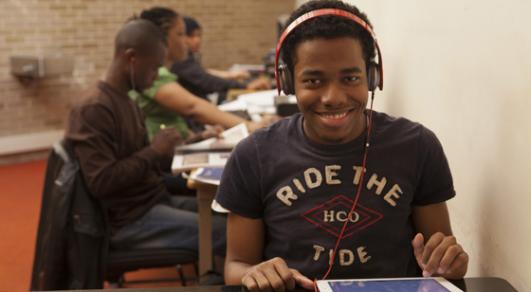Boosting the Life Chances of Young Men of Color
Evidence from Promising Programs

Despite progress on many fronts, young men of color still face many obstacles to success in American society and suffer disproportionately from economic and social disadvantage. In recent years, foundations and state and local governments have launched major initiatives to address this pressing issue. For example, in 2011, the City of New York created the Young Men’s Initiative, a $42-million annual program, supported by Bloomberg Philanthropies and the Open Society Foundation, to invest in the success of the city’s young men of color. In February of this year, the Obama Administration announced “My Brother’s Keeper,” a multimillion-dollar push by the government, foundations, and businesses to “build ladders of opportunity and unlock the full potential of boys and young men of color.”
In light of the momentum building to improve the fortunes of young men of color, this review takes a look at what is known about this population and highlights programs that are shown by rigorous research to be making a difference. It first examines the special challenges and struggles of these young men in the labor market, including problems related to their disproportionate involvement in the criminal justice system and their experiences in the educational system. A growing number of young men of color have become disconnected from the positive systems, institutions, and pathways designed to help people achieve success — high school diplomas, enrollment in and completion of postsecondary education or training, and ultimately career ladders leading to well-paying jobs.
Given these facts, the natural next question is: What can be done? Does this group of young men constitute, as some have labeled them, a “lost generation”? Or are there interventions that can provide real hope and real results? Can the nation’s institutions do a better job of increasing educational and labor market opportunity? Is there, in fact, a way to move away from deficit-focused characterizations of young men of color to ones that recognize and build on their resilience and strengths?
The second section of the paper reviews the results from high-quality, randomized controlled trials involving young men of color, some conducted by MDRC and some by other groups. It highlights a number of promising interventions, casting doubt on the conventional wisdom that nothing can be done. Interventions are divided into two broad categories: (a) Proactive Approaches: preventive interventions aimed at youth who are still connected to positive systems (like schools or community colleges) that seek to enhance their success in moving through those systems and on to productive careers in the labor market and (b) Reconnection Approaches: interventions targeting those who have disconnected from positive systems, who have dropped out of school or the labor market, or who have been sent to jail or prison and are relying upon the second-chance system to help reintegrate into their communities. The final section of the review discusses some promising ideas and interventions that could provide new models for improving outcomes for young men of color.
Policy interest in assisting young men of color has waxed and waned over the years, and not enough has been learned from past efforts to build better policies and programs. It is hoped that current efforts will include a robust documentation and learning agenda to ensure that the knowledge base of successful strategies grows larger. It is critical to harness the current interest to build on what is known — and learn more about what is still not understood — to finally make a lasting difference in the lives and future prospects of this group.







